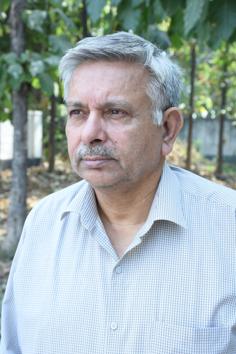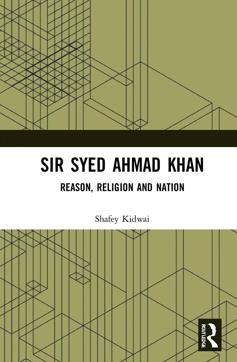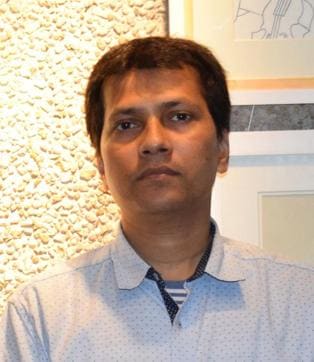Interview: Shafey Kidwai, author of Sir Syed Ahmad Khan: Reason, Religion and Nation
The critic says that Sir Syed, the founder of Aligarh Muslim University, argued that religion, science and morality were mutually consistent
The author, critic and columnist, and the chairman of the Department of Mass Communications at Aligarh Muslim University (AMU), on his forthcoming book on the legacy of Sir Syed Ahmad Khan, the founder of the institution, whose birth anniversary is celebrated on October 17

Your new book, Sir Syed Ahmad Khan: Reason, Religion and Nation (Routledge) looks at the life and times of the founder of AMU, who was a pioneer of modern education among Muslims in India in the 19th century. What are some of his ideas that are still relevant?
Sir Syed Ahmad Khan (1817-1898) is well known as the founder of AMU. However, his real legacy rests in his radical views and adumbrations on a wide range of issues, like the concept of blasphemy, jihad, cow sacrifice, gender equality, conversion, Hindu-Muslim unity and reservation for Muslims. In my book, I discuss his contributions beyond the sphere of education and dwell on his role as a public intellectual, as a multifaceted Muslim renaissance man in 19th century British India, gleaning his concepts from his actions and his writings. I contextualise his ideas and writings in the broader framework of political, social, and religious reforms, nationalism, and the debate on identity and subjugation. Sir Syed focused a lot on liberal values, tolerance and abhorrence of obscurantism.
One of Sir Syed’s real legacies that makes him relevant even today is his tolerance and propagation of liberal values — he wrote extensively on the various ways to live in a plural society. He was a great advocate of religious tolerance and constantly appealed to Muslims not to be swayed by the rhetoric-prone society of those days. He was the first Muslim scholar who attempted an Urdu commentary on the Bible, Tabin al-al-kalam Fi tafsir altawrat Wa ‘I-injil’ala millat al Islam (Elucidation of the World in Commentary of the Torah and Gospel According to the Religion of Islam), which was published in three parts between 1860 and 1865. A critic of cow sacrifice, he wrote against it extensively and ensured that beef, which was freely available at that time, was not served in Aligarh.
Sir Syed’s stance on blasphemy is also something that holds great relevance today. In the Islamic state, writing against Islam or the Prophet meant writing against the state which attracted capital punishment. Today’s sedition law could be seen as the new, secular vocabulary for blasphemy. In 1858, Sir William Muir, a civil servant and orientalist, published two volumes of a contemptible book on Prophet Muhammad — The Life of Mahomet and History of Islam to the Era of Hegira — it incensed the Muslim community. But Sir Syed believed that instead of burning books, it was important to present a counter argument in the form of another book. In 1870, he came up with his rejoinder, Khutbaat-e-Ahmadiyya, debunking the misconceptions and misunderstandings surrounding the Prophet after the release of Muir’s book. This holds out a lesson on the effectiveness of writing back.

Many of Sir Syed’s ideas were iconoclastic. You write that despite having studied theology, he was a rationalist who considered reason to be the “deeply purest form of human intelligence that could also be exercised upon faith”.
Sir Syed denounced miracles in Islam that the theologians always took as gospel truths. For instance, Gabriel is considered in Islam to be the archangel who was the messenger of God who brought His revelations verbatim to Prophet Muhammad. Besides, the crossing over of the Red Sea by Moses and the drowning of Pharaoh or Firaun (several verses in Quran describe how the Red Sea was split in two and a dry path emerged as Moses banged the water with his stick on divine inspiration), and an abortive attack on Kaaba by Abraha, a Christian ruler of Yemen, in 570 AD, are generally considered to be miracles. Sir Syed questioned these assumptions and offered a rational interpretation for them. He held that Gabriel had come in human form to bring God’s message to Mary and the divine revelation was a kind of noor (light) that glowed in the heart of the Prophet Muhammad. Similarly, Sir Syed argued that when Moses was crossing the 30 km patch known as Bay of Eden, comprising 30 islands and surrounded by mountains, the rise and fall in the level of water was due to the high and low tide. Quran describes that Abraha’s army was trampled by a fleet of Ababeel (pebble-carrying birds) that, ordained by God, rained little but deadly stones on them. Contradicting this, Sir Syed claims that Abraha’s army was infected with chickenpox.
According to Sir Syed, the world we live in is governed by two sets of promise by God: the word of God or the Holy Quran, and the work of God, that is the law of nature. The whole universe revolves around it. He held that one divine promise can’t contradict the other and that there should be no dichotomy between the word of God and the work of God. He looked upon miracles or events that defied cause and effect as going against the elemental mechanism of creation. These interpretations were unprecedented. No Muslim scholar had ever attempted anything of this sort before Sir Syed. His religious thought helped promote rationalism among Muslims, which remains an area of huge concern even today. He wanted reason to be the arbiter of life. He was the only Muslim scholar to have a discourse on reason. Other scholars and reformists like Al-Ghazali and Shah Waliullah were against reason.
Was there any common meeting ground for his radical ideas and religious beliefs?
While advocating rational thinking, scientific temper and free enquiry, Sir Syed argued that religious beliefs, scientific knowledge and morality were mutually consistent. He held that moral values must be inculcated. He talks of truth and ikhlaaq (good behaviour). Today, living in a post-truth world, we create truth through language to fulfil our cultural needs. Sir Syed emphasised on truthfulness two centuries ago. He wrote a great deal on human traits, like sycophancy (khushamad), which he termed as a disease. Before him, nobody had touched upon these issues in Urdu writing. Many of his articles are about tehzeeb (culture), the past and inertia. In a maulvi-oppressed society, Sir Syed was the voice of reason who believed in the convergence of science and faith.
His regressive ideas on women and their education, however, come in for heavy criticism from several quarters. What shaped his views on women’s education?
When it came to women’s education, Sir Syed exhibited his feudal mindset; in some ways, he became the voice of patriarchy. He wanted tutor-based home education for women. He was also a proponent of purdah; it was his blind spot. He was not a supporter of co-education since he felt that girls reaching the age of puberty would make it hard for them to attend schools during their menstrual period. He wanted separate schools for both genders. He also feared that since girls usually excelled in studies, they would eventually outshine boys and, thus, end up jeopardising the institution of marriage; he considered marriage to be the ultimate goal for girls. This was very ill-conceived. After all, reform had to take place simultaneously. The Prophet didn’t ask only men to follow Islam, excluding women and children, but all of them together.
However, just to absolve the social reformer, one could argue that, unlike many Urdu travelogue writers, like Yusuf Husain Kambalposh, who referred to European women as “promiscuous”, the male gaze is missing in the accounts of Sir Syed, who saw them as empowered. In his writings, Sir Syed’s contradicts himself at several places. All great men’s lives are mired in contradictions. And he is no different.

What are his contributions as an administrator?
As a member of the Viceroy Council and the Public Service Commission, he stood for the codification of law and for reservation for Muslims at the political level. As an administrator, he didn’t discriminate between class or religion or gender. His administrative actions were meant for every Indian. When he became a member of the public service commission, he made two demands: the age limit for the Indian Civil Service be raised to 23 from 21, and the ICS examination to also be held in Delhi or Kolkata.
In 1882, the Local Self-Government Bill spoke of direct franchise that could lead to Hindus electing Hindus and Muslims electing Muslims. He suggested that the government reserve one third seats for minorities so that they could be protected. He wanted reservation for Muslims at the political level, but not at the level of jobs, where one could empower oneself through education. He offered a flexible fee structure to poor students, which showcased how serious he was about education.
Nawaid Anjum is a Delhi-based freelance feature writer, translator and poet.



